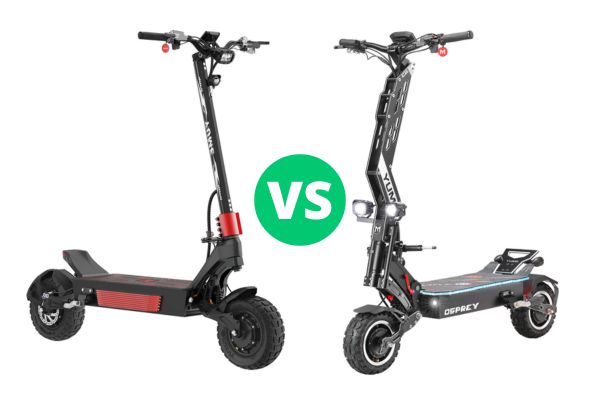In the fast-growing world of high-performance electric scooters, few brands have created as much buzz as Yume. Originally known for value-packed budget models, Yume has shifted its focus toward building serious, high-powered machines that can compete with top brands. Two standout examples of this shift are the Yume Predator and the Yume Osprey.
At first glance, both scooters might seem similar; they’re fast, powerful, and built for serious riders. But once you look closer, you’ll realize they’re very different in how they’re designed, what they offer, and who they’re really built for.
This article breaks down everything you need to know about these two hyper-scooters. We’ll compare their specs, performance, ride feel, long-term value, and who they’re best suited for. If you’re stuck choosing between them, this guide will help you make the right decision based on your riding style, budget, and expectations.
Yume Predator vs Osprey
Before diving into real-world riding impressions, it helps to look at the numbers. These specs paint a clear picture of what each scooter brings to the table. For a fair comparison, we’ll use the upgraded Osprey with the premium Samsung battery pack.
| Metric | Yume Predator | Yume Osprey (Samsung Version) |
| Price (Sale) | $3,299 – $3,699 | $2,199 – $2,849 |
| Top Speed | 63 mph (100 km/h) | 60 mph (96 km/h) |
| Motor Power (Nominal) | Dual 4000W | Dual 3500W |
| Peak Power Output | ~10,080W | ~10,080W |
| Battery Voltage | 72V | 72V |
| Battery Capacity | 50Ah (3600Wh) | 40Ah (2880Wh) |
| Battery Type | Panasonic EV Cells | Samsung 21700 Cells |
| Charge Cycles | ~2000 | ~500 |
| Max Range (Claimed) | 100 miles | 100 miles |
| Controller Type | Liquid-Cooled Custom | 18 Mosfet Sine Wave |
| Brakes | Quad-Piston Hydraulic | ZOOM Dual-Piston Hydraulic |
| Suspension | Triple Hydraulic | Dual Hydraulic |
| Tires | 13-inch Tubeless | 11-inch Tubeless |
| Weight | 170 lbs (77 kg) | 123 lbs (56 kg) |
| Max Load | 330 lbs (150 kg) | 330 lbs (150 kg) |
| Display | TFT Color Display (IP67) | LCD Display (IP65) |
| Special Features | Removable Battery, Liquid Cooling | Interchangeable Throttles |
Looking at these numbers, it’s clear that the Predator has the edge in battery size, advanced features, and durability. But the Osprey is lighter, more nimble, and much more affordable, making it a serious contender.
Motor Performance: Nominal vs. Peak Power
Both scooters are incredibly powerful. The Predator comes with dual 4000W motors, while the Osprey uses dual 3500W motors. On paper, that means the Predator has 1000 more watts of nominal (continuous) power. However, both scooters are advertised with similar peak power, around 10,080W, which gives them explosive acceleration.
The difference shows up in how long each scooter can hold that power. This depends largely on the controller system and how well the scooter handles heat.
Controller Systems: Liquid Cooling vs. Sine Wave
This is where things really split. The Yume Predator is one of the first production scooters to feature liquid-cooled controllers. That means when things heat up, like during long climbs or riding fast in hot weather, there’s a special cooling system that pumps liquid around the controllers to prevent them from overheating. This keeps performance strong even under stress.
The Yume Osprey uses standard sine wave controllers. These are smooth, reliable, and very common in high-end scooters. They offer quiet operation and excellent throttle control. But they rely on passive cooling. In extreme riding conditions, they can get hot and reduce power to protect themselves, something called thermal throttling.
So, if you’re riding aggressively or in hot weather for long stretches, the Predator will keep pulling strong, while the Osprey might slow down slightly to protect its systems.
Predator: EV-Grade Panasonic Cells
The Predator takes a completely different path from most scooters. Instead of using hundreds of small cells, it uses just 20 large Panasonic EV-grade cells, the same kind used in electric cars. These cells are built for durability and long life.
They’re rated for around 2000 charge cycles, which is about four times more than the usual 21700 cells. This means you can ride much farther over the life of the battery, up to 120,000 miles if you charge regularly and maintain it well.
Also, the battery is removable. You can take it inside to charge, swap it out, or upgrade in the future. This adds real convenience, especially if your scooter lives in the garage or if you’re storing a second battery.
Osprey: Samsung 21700 Reliability
The Osprey uses a more traditional battery system with Samsung 21700 cells, known for their good performance, safety, and reliability. These are common in many high-performance scooters and work very well.
However, they have a shorter lifespan, typically around 500 charge cycles. That still gives you thousands of miles of use, but if you ride every day or over long distances, you’ll eventually need to replace the battery. The Osprey doesn’t offer a removable battery, so replacing it is more complicated.
Real-World Range & Long-Term Costs
Although both scooters are marketed with a 100-mile range, the larger 3600Wh battery in the Predator will clearly go farther. Real-world conditions like hills, rider weight, and speed reduce range. On average:
- Predator realistic range: ~60 miles
- Osprey realistic range: ~45 miles
Now let’s look at total cost over time, assuming 25,000 miles of riding:
| Metric | Predator | Osprey |
| Price | ~$3,599 | ~$2,699 |
| Battery Replacements | 0 | 1 (likely needed) |
| Battery Cost | ~$1,500 | ~$1,000 |
| Total Lifetime Cost | ~$3,599 | ~$3,699+ |
Even though the Osprey is cheaper upfront, the Predator becomes more affordable over time due to its long-lasting battery.
The Art of the Ride: Suspension, Stability, and Terrain Dominance
Predator: Stability and Comfort
The Predator rides on huge 13-inch off-road tires. These soak up bumps and handle rough roads or dirt trails with ease. Combine that with a triple hydraulic suspension (one shock in front, two in back) and you get an extremely stable and cushioned ride, even at high speeds.
The extra weight (170 lbs) also helps it feel “planted” to the road, reducing vibrations and giving it a luxury feel. Some riders compare it to riding a Cadillac, smooth and confident.
Osprey: Agility and Control
The Osprey uses 11-inch tubeless tires and dual hydraulic suspension. It’s lighter by almost 50 lbs, which makes it feel quick and nimble. Turning is easier, and it feels more responsive to small inputs.
But lighter weight also means it’s a bit more sensitive at high speeds. Some riders report slight wobbles above 50 mph, especially without a steering damper (a common aftermarket add-on). Still, for many, this scooter strikes a perfect balance between performance and playfulness.
Form, Function, and Rider Interface
Build Quality and Design
The Predator is heavier, but it also feels more “premium.” It has excellent internal wiring, a large deck, and a clean, finished look. Everything feels tight and well-built.
The Osprey is simpler and more utilitarian, but still solid. It’s easier to move around and more portable,if you need to lift it into a car or bring it inside occasionally, the Osprey is a better fit.
Display and Rider Controls
The Predator includes a bright TFT color display, which is easy to see in sunlight and is rated IP67 waterproof. It looks high-end and provides lots of riding data.
The Osprey has a large LCD screen (IP65-rated), which works well but doesn’t have the same premium feel.
The Osprey wins on throttle flexibility; it comes with two throttle types: a thumb push and a trigger pull, both easily swappable. The Predator includes a high-quality trigger throttle only, though some riders really prefer it.
Both models include NFC unlocking and support for a smartphone app for settings, diagnostics, and ride tracking.
Final Verdict: Tailoring the Choice to the Rider
This isn’t about picking a winner. It’s about choosing the scooter that fits your needs.
Why Choose the Yume Predator?
Choose the Predator if you:
- Ride long distances regularly
- Live in a hot climate
- Want the latest technology
- Care about long-term savings
- Prefer comfort and stability over agility
- Don’t mind a heavier scooter
- Plan to keep it for many years
The Predator is a smart investment for riders who value performance, reliability, and durability. If you’ve had issues with overheating scooters or weak batteries, this machine solves those problems with real innovation.
Why Choose the Yume Osprey?
Choose the Osprey if you:
- Want maximum performance per dollar
- Prefer a lighter, more agile ride
- Are new to hyper-scooters
- Don’t plan to ride every day
- Value upfront savings over long-term economics
- Enjoy customizing your scooter (like throttle or steering damper)
The Osprey delivers almost everything the Predator does, speed, power, and excitement,at a much lower price. It’s the best value option for riders who want to go fast without emptying their wallet.
Conclusion: Two Scooters, One Perfect Fit for You
The Yume Predator and the Yume Osprey are both outstanding scooters. But they are made for different kinds of riders.
The Predator is a serious, future-ready machine. It’s packed with innovative tech like liquid cooling and EV-grade batteries. It’s built for long-term riders who want the best and are willing to invest more upfront to save more later.
The Osprey, meanwhile, is a performance bargain. It gives you 90% of the Predator’s thrill for a lot less money. It’s ideal for riders who want to hit 60 mph and feel the rush without worrying about longevity or premium features.
In the end, it comes down to what you value most: tech and durability, or agility and affordability.
No matter which you choose, you’re getting one of the best 72V electric scooters on the market today. And that’s a win in any rider’s book.




